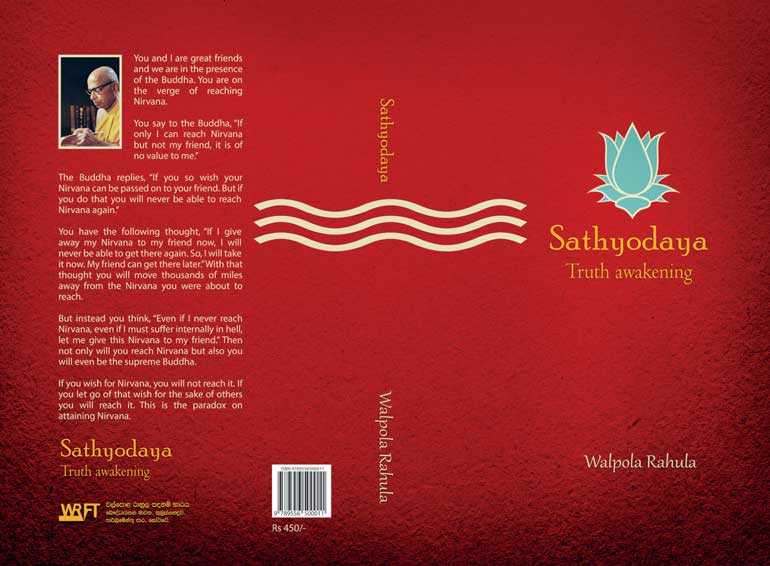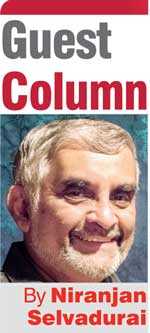Thursday Feb 27, 2025
Thursday Feb 27, 2025
Wednesday, 10 April 2019 00:00 - - {{hitsCtrl.values.hits}}

“May the Buddha Sasana glow!” (Budhu Sasuna babalewa!) – I remember seeing this message written on the back of a lorry when I was a boy. That was more than 50 years ago, back in Colombo. Those words fascinated me then.
I recall watching the Vesak pandals with my parents. Those magnificent colour lights flashing, changing, moving, together with the radiant artistic illustrations of Jathaka stories had me entranced. The mesmerising Vesak pandal at the Borella junction was perhaps a glowing example of the Buddha Sasana. That was my childhood impression.
I was aware that the Sri Lankan Government had a minister for the Buddha Sasana. That position has been in existence since the 1990s irrespective of the side in power. However, I had not given much consideration to what the ‘Buddha Sasana’ should represent until recently. It was only after I commenced the translation of the ‘Sathyodaya’ into English at the request of the Walpola Rahula Institute, that I had a truth awakening.
The original Sinhala version of this book was written about 85 years ago by Ven. Walpola Rahula. The English version of ‘Sathyodaya’ (‘Truth Awakening’) was launched on 29 March by the Walpola Rahula Foundation Trust.
What is the Buddha Sasana?
In ‘Sathyodaya,’ Ven. Rahula clarifies any misconception about the Buddha Sasana.
“It is not some construction made of bricks and cement. ‘Buddha Sasana’ signifies performing wholesome actions and refraining from unwholesome deeds. It is about cleansing the mind. It is represented by ethical conduct (Seela), mental discipline (Samadhi) and wisdom (Pragna). Virtuous practice is ‘Buddha Sasana’.”
Now could this be a view point expressed Venerable Rahula rather than what is stated the Tripitaka? With the Theravada Tripitaka now declared as a National Heritage item, this is an aspect that requires further exploration.
 On one occasion the Buddha’s disciple and attendant Venerable Ananda asked the Buddha whether the fundamental instructions to bhikkhus given by the preceding Buddhas were the same as those of the Buddha himself.
On one occasion the Buddha’s disciple and attendant Venerable Ananda asked the Buddha whether the fundamental instructions to bhikkhus given by the preceding Buddhas were the same as those of the Buddha himself.
The Buddha’s response is included in the Dhammapada (Verse 183).
“Sabbapapassaakaranam
kusalassaupasampada
sacittapariyodapanam
etambuddhanasasanam”
This can be translated as:
“Not to do evil, to cultivate merit, to purify one’s mind – this is the teaching (Sasana) of the Buddhas.”
These words of the Buddha could very well serve as the mission statement of Sri Lanka’s Buddha Sasana Ministry.
The Sasana of a Buddha is clearly his teaching or doctrine. Ven. Rahula was simply restating and explaining the Buddha’s words. In fact he was providing an ‘Anu-sasana’ to the ‘Sathyodaya’ readers.
Protectors of the Buddha Sasana
‘Sathyodaya’ goes on to provide an illuminating discussion on who should be accountable for protecting the Buddha Sasana. Is it the gods, the Sangha or the lay followers?
Ven. Rahula emphasises that the Buddha Sasana “is not something tangible that the gods can safeguard in the same way a watchman protects a land”. He points out that gods frequently have been unable to save from harm even places of worship built in their own names. He concludes that as the founder of this teaching was a human being, the onus for safeguarding this teaching remains with us humans through diligent practice.
He further iterates, “Protecting the legacy of the Buddha involves avoiding unwholesome activities, living righteously in accordance to the teaching and purifying our minds. Any person following these practices will be a protector of the Buddha Sasana.”
Ven. Rahula argues against the widely accepted notion that ‘the Buddha Sasana will survive only if there are robe-wearers’. He affirms that if the continued existence of the Buddha’s teaching is dependent on type of clothing such as a robe, then that teaching must indeed be of very low value.
‘Sathyodaya’ stresses that “the Buddha’s teaching is universal and for the benefit of all beings”. As the Buddha did not limit his doctrine to specific group of people the unwholesome actions of anyone would be a stain against his legacy.
Then Ven. Rahula astutely points out that “even if a Christian or a Muslim performs a wrongful deed, it is still a black mark against the legacy of the Buddha”. The ultimate message is clear. There should not be a separation of us and them. Everyone in the society which includes the Sangha, the lay followers and persons of other religious identities, have a role play in the protection of the Buddha Sasana by living righteously.
On the question of ‘Who is a Buddhist?’ Ven. Rahula offers the following profound thought:
“The Buddhist name tag will not help you to reach Nirvana, but the ‘Buddhist conduct’ will assist you to get there. A person will not become a Buddhist by merely taking refuge in the triple gem through a verbal utterance. Nor will the person be a Buddhist by simply wearing a robe. There are many with false views who are parading as Buddhists. There could be true Buddhists among those who wear the cross and others going under another religious label.”
Ven. Rahula also alludes to a flawed accountability model in our society that has hindered the Buddha Sasana. The lay community appears to have handed over the contract of safeguarding the Buddha Sasana to the Bhikkhus. The necessary food, drink, clothing and accommodation for the monastics is provided by the lay community. By doing that they feel that they have fulfilled their obligation. After all they have very busy lives. So surely, they cannot be expected to keep precepts and develop virtuous qualities. Let the Bhikkhus do their bit and protect the Sasana.
Extending this line of thought, let the Theravada Tripitaka be declared as a national heritage. Let the Bhikkhus come up with a pristine version of the scriptures for the future generations. Let the imposters in robes be identified. However, the most significant component, the need to practice the teaching, appears to have been excluded from this model.
On rituals and caste-based segregation
Ven. Rahula is critical of the many rites and rituals (Sīlabbata-parāmāsa) that been established as a Buddhist practices today. He points out that this is a un-Buddhist concept being adopted over many generations without necessary inquiry or censure. He perceives that “Blindly bowing down to any tradition that comes down the generations is a fundamental weakness of an untrained mind.”
On Buddha puja, he points out that placing large quantities for food in front of Buddha statues and then throwing it away is a misguided custom. He aptly summarises that “food should be given to the hungry. Clothes should be given to those who do not have sufficient clothes. Shelter should be provided to the homeless. The sick should be cared for with love and compassion. These are the offerings we can make to the Buddha.”
The Buddha stood firmly against the discriminating of persons based on caste. The Vasala Sutta (Discourse on Outcastes) states: “Not by birth is one an outcaste; not by birth is one a Brahman. By deed one becomes an outcaste, by deed one becomes a Brahman.” ‘Sathyodaya’ cites the stories of Suneetha, the street sweeper and Upali the barber who were ordained by the Buddha regardless of their origins.
However, it is well known that a leading Buddhist monastic order in the country restricts its ordinations to the members of a single caste even though it accepts donations from the entire community. Ven. Rahula holds back no punches when he states, “It pains me that the so-called protectors of the teaching are in fact destroying it.”
Discussing the suitability of a person monastic life he asserts: “If a person is born into a high caste is of low upbringing, he will be unsuitable for a monastic life. The decision to enter a monastic life should be based on character and conduct of the individual and not on the caste at birth.”
Perhaps the time has come for the high priests who are custodians of the Theravada Tripitaka to step up to protect our national heritage.
Towards ‘Truth Awakening’
Ven. Rahula encourages us to explore the teaching with a critical and inquiring mind. He regularly invokes the spirit of free thinking expressed in the Kalama Sutta. He points out that in society today it is natural to have conflicting views in any subject and that religion is no exception. His intention is to promote a healthy dialogue that enable us to arrive at the truth. He however points out, “The truth cannot be revised and made easy so that an unwise person may understand it, if we attempt this the truth may be distorted and provide a wrong teaching.”
Let us also heed to the valuable counsel provided by Ven. Dhammananda in the introduction to ‘Sathyodaya’ – ‘Truth Awakening’. He highlights that “the intention of this book is not to turn you into a fierce critic. As a bowl of dirty water ultimately becomes clean when clean water is continuously poured into it; learn to be a patient and compassionate mediator.” We need to cultivate the habit of changing our perspective based on proper understanding and gradually induct others into this process.
Ven. Rahula observes that, “The Sri Lankan society remains in a docile state in relation to exploring and probing the truth. Almost everyone, from the knowledgeable scholar down to the man in the street, accepts tradition and whatever is written in books with much reverence. Little effort is made to validate and establish the truth.”
A captain of our national cricket team (we have had many in recent times) won his maiden series as skipper. At a media interview he thanked the soothsayer who had predicted this victory and stated that he had followed her advice and instructions to the letter. Oh really! Then I thought of that little boy who once stood at the crowded Borella junction, with wide eyes and mouth agape staring at a magical Vesak pandal thinking to himself, “This must be the glowing Buddha Sasana. How fortunate am I to see this!”
I think the time is ripe for all of us for a truth awakening. Don’t you? And then ‘May the Buddha Sasana glow!’
(The writer is based in Sydney, Australia, and is the translator of ‘Sathyodaya’.)
Discover Kapruka, the leading online shopping platform in Sri Lanka, where you can conveniently send Gifts and Flowers to your loved ones for any event including Valentine ’s Day. Explore a wide range of popular Shopping Categories on Kapruka, including Toys, Groceries, Electronics, Birthday Cakes, Fruits, Chocolates, Flower Bouquets, Clothing, Watches, Lingerie, Gift Sets and Jewellery. Also if you’re interested in selling with Kapruka, Partner Central by Kapruka is the best solution to start with. Moreover, through Kapruka Global Shop, you can also enjoy the convenience of purchasing products from renowned platforms like Amazon and eBay and have them delivered to Sri Lanka.
Discover Kapruka, the leading online shopping platform in Sri Lanka, where you can conveniently send Gifts and Flowers to your loved ones for any event including Valentine ’s Day. Explore a wide range of popular Shopping Categories on Kapruka, including Toys, Groceries, Electronics, Birthday Cakes, Fruits, Chocolates, Flower Bouquets, Clothing, Watches, Lingerie, Gift Sets and Jewellery. Also if you’re interested in selling with Kapruka, Partner Central by Kapruka is the best solution to start with. Moreover, through Kapruka Global Shop, you can also enjoy the convenience of purchasing products from renowned platforms like Amazon and eBay and have them delivered to Sri Lanka.